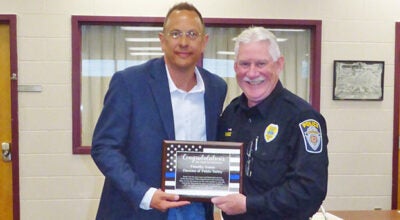Temps fill gap while hospital recruits
Published 11:39 pm Tuesday, February 7, 2012
Borgess Lee-Memorial Hospital injected a new term into Dowagiac medical dialogue — locum tenens.
It means a person who stands in temporarily for someone else of the same profession — especially doctors or clerics.
“Right now we have three locum tenens positions,” Administrator and Chief Operating Officer Joy A. Strand said in an interview Monday. “We have one through the end of March we could extend and two until the end of June we could extend. Two internal medicine and one family practice are locums. We have two permanent family practice and one permanent internal medicine. We have six doctors available for the community” — five across Main Street at Borgess Lee Medical Group in the Donald Lyons Health Center and one in what had been Dr. James Wierman’s practice on W. Division Street.
“In the meantime,” Strand said, “we are recruiting permanent physicians,” including five primary care doctors, a surgeon and a pediatrician.
“Everybody is fighting to attract internal medicine and family practice primary care doctors,” Borgess Health spokesman Jim Rohrback said. “It’s tough everywhere, even big cities. They’re developing a new medical school in Kalamazoo (for fall 2013 through Western Michigan University) and you’d love to see them train primary care doctors. Fact of the matter is, a lot of training is always in specialties where there might not be as many shortages. Joy has been living recruiting for months.”
“I’m just starting work on developing relationships with medical students early in their career, particularly to work with (WMU) to get a rural training track into the medical school curriculum so they do some of their three-year residency in a rural area. Where they do their residency, 50 percent stay in that area.”
Rohrback, who lives in Decatur, said Dowagiac benefits from already having “a model for health care in the future. Midlevels (physician’s assistants and nurse practitioners) are becoming more and more important in delivering primary care, taking pressure off a doctor shortage that will probably be with us forever.
“These people are quite skilled and experienced and PAs and NPs will sit down with you unless there’s something serious they think a doctor should see and take care of 90 percent. We’ve got a 15-minute adult and pediatrics walk-in clinic across the street from a 30-minute ER. That doesn’t exist in too many places, having two places to ‘shop,’ so to speak, one for serious stuff. That’s unusual.”
“That’s an important trend in medicine,” Strand said. “The increased use of midlevel providers because of the physician shortage. There are only so many doctors to go around for serious and acute. A midlevel can take care of a sore throat — or identify that it’s more than a sore throat.”
As to why doctors are in short supply, Strand explained, “It’s a tough profession with a lot of expensive schooling. Nowadays, there are a whole lot more attractive professions. When Dr. Wierman went to medical school, you never heard of Silicon Valley or IT. The younger generation looks for a different work-life balance. Medicine is 24/7. A lot of young people don’t want to work weekends or nights, they want to be home with their families. It’s really not as attractive as it once was with regulations and malpractice. The evolution to physicians who only work in the hospital and only take care of hospital patients impacted medicine. That’s attractive to certain types of physicians because they get to practice medicine on sick people, which they like, but they’re done at the end of their shift and somebody else takes over.”
The hospital published a glossy 12-page booklet about Dowagiac, “A Place to Practice Medicine and Call Home.”
While it’s “hugely hard to compete in a rural area,” Cass County being nestled near the cultural advantages of Chicago and the natural splendor of Lake Michigan helps. Affordable housing, Southwestern Michigan College and the home of the Dogwood Fine Arts Festival also merit mention.
Quality of life plays as big a part in the brochure as the emergency department tripling in size in 2009 or Borgess Health and Borgess-Lee Memorial being part of the largest non-profit health care system in the United States.
“One of the critical pieces in recruitment is you not only recruit the physician, you recruit the spouse,” Strand said. “What amenities do they want in the town they live? Dowagiac has great advantages compared to the (Upper Peninsula), where I worked for 20 years.
“I didn’t have Notre Dame in my backyard or a mall within 25 miles. Try to attract a spouse to the UP when they’ve trained in major metro centers.”







